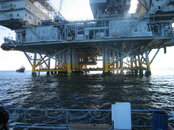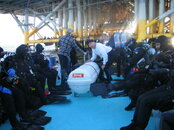fisherdvm
Contributor
- Messages
- 3,577
- Reaction score
- 52
- # of dives
- 200 - 499
Last weekend, another diver told me "I don't consider a dive a real dive, unless we are at least 70 ft deep.
Well, this morning, I found my dive very difficult. My son lost one of his fin (had no idea where he lost it) when we dove 2 weeks ago. So I had about 1/4 of an acre to cover. I roughly know that it was when we were in the shallow, practicing our skills.
As much of the dive is 4 to 10 ft deep, it was hard to maintain buoyancy. As the bottom is pure muck, I can't scrape it without causing a dust storm. The lake is treated with copper sulfate and dye, so the vis was about 3 ft to 4 ft.
Fortunately, I was perfectly weighted and had no air in my bc, and had more problem keeping down than floating up. I did about 18 passes, going through the same territory twice (amazingly it wasn't too mucked up!). And my last pass, before giving up - the fin was on the bottom, sticking straight up at 5 ft depth!!
What I learned is - flutter kicks are fine for recreational diving, but the frog and modified flutter is a must for search and recovery. Second, if I didn't have perfect weighting, this shallow dive would've been impossible.
I still don't think deep dives are challenging. That's just my opinion.
Well, this morning, I found my dive very difficult. My son lost one of his fin (had no idea where he lost it) when we dove 2 weeks ago. So I had about 1/4 of an acre to cover. I roughly know that it was when we were in the shallow, practicing our skills.
As much of the dive is 4 to 10 ft deep, it was hard to maintain buoyancy. As the bottom is pure muck, I can't scrape it without causing a dust storm. The lake is treated with copper sulfate and dye, so the vis was about 3 ft to 4 ft.
Fortunately, I was perfectly weighted and had no air in my bc, and had more problem keeping down than floating up. I did about 18 passes, going through the same territory twice (amazingly it wasn't too mucked up!). And my last pass, before giving up - the fin was on the bottom, sticking straight up at 5 ft depth!!
What I learned is - flutter kicks are fine for recreational diving, but the frog and modified flutter is a must for search and recovery. Second, if I didn't have perfect weighting, this shallow dive would've been impossible.
I still don't think deep dives are challenging. That's just my opinion.






